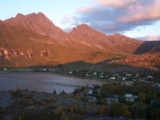
Steigen
Encyclopedia
Steigen is a municipality
in Nordland
county
, Norway
. It is part of the Salten
traditional region
. The administrative centre of the municipality is the village of Leinesfjord
.
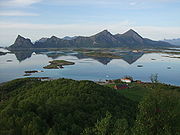

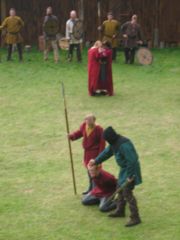
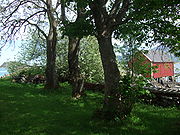
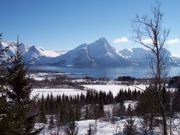 Steigen was established as a municipality on 1 January 1838 (see formannskapsdistrikt
Steigen was established as a municipality on 1 January 1838 (see formannskapsdistrikt
). The new municipality of Leiranger
was separated from Steigen on 1 September 1900. On 1 January 1964, Leiranger was again merged with Steigen along with the neighboring municipality of Nordfold
.
) is named after the old Steigen farm (Old Norse
: Steig), since the first church was built there. The name is derived from the verb stíga which means "mount" or "rise" and it is referring to the high and steep mountain Steigtinden (tinden means "the peak") behind the farm.
is from modern times. They were granted on 12 October 1988. The arms show three black-colored axe
heads from the Viking Age
.
, well inside the Arctic Circle
. The road to Steigen departs from European route E6
and makes use of the 8 kilometres (5 mi) long Steigentunnelen (see World's longest tunnels). Steigen borders Hamarøy
municipality in the north and Sørfold
municipality to the south. Vestfjord
and Lofoten
is located west of Steigen. The municipality is mainly located on a peninsula
dissected by many fjord
s. Steigen also includes several island
s. The largest island is Engeløya
, where there are ancient burial mounds
(such as Sigarshaugen) and the world's most northerly
naturally occurring Hazel
forest in Prestegårdsskogen nature reserve
. The largest glacier is Helldalsisen encircling a 1361 metres (4,465 ft) mountain
. Lakes in the region include Forsanvatnet
.
Steigen has fertile lowlands in between the mountains and the sea. There are several archeological sites showing settlements from the Bronze age
, Iron age
, and Viking age
.
Municipalities of Norway
Norway is divided into 19 administrative regions, called counties , and 430 municipalities...
in Nordland
Nordland
is a county in Norway in the North Norway region, bordering Troms in the north, Nord-Trøndelag in the south, Norrbottens län in Sweden to the east, Västerbottens län to the southeast, and the Atlantic Ocean to the west. The county was formerly known as Nordlandene amt. The county administration is...
county
Counties of Norway
Norway is divided into 19 administrative regions, called counties . The counties form the primary first-level subdivisions of Norway and are further divided into 430 municipalities...
, Norway
Norway
Norway , officially the Kingdom of Norway, is a Nordic unitary constitutional monarchy whose territory comprises the western portion of the Scandinavian Peninsula, Jan Mayen, and the Arctic archipelago of Svalbard and Bouvet Island. Norway has a total area of and a population of about 4.9 million...
. It is part of the Salten
Salten
Salten is a district in Nordland in North Norway, consisting of the municipalities Meløy, Gildeskål, Bodø, Beiarn, Saltdal, Fauske, Sørfold, Steigen and Hamarøy. The district borders Helgeland in the south , Ofoten in the north, Sweden in the east and Vestfjorden in the west...
traditional region
Districts of Norway
The country Norway is historically divided into a number of districts. Many districts have deep historical roots, and only partially coincide with today's administrative units of counties and municipalities. The districts are defined by geographical features, often valleys, mountain ranges, fjords,...
. The administrative centre of the municipality is the village of Leinesfjord
Leinesfjord
Leinesfjord is the administrative centre of Steigen municipality, Norway....
.





Formannskapsdistrikt
Formannskapsdistrikt was the name for a Norwegian local self-government districts put into force in 1838. This system of municipality was created in a bill approved by the Storting and signed into law by King Carl Johan on 14 January 1837...
). The new municipality of Leiranger
Leiranger
Leiranger is a former municipality in Nordland county, Norway. The administrative centre was Leines.Leiranger was separated from Steigen September 1, 1900. The new municipality had a population of 1.117....
was separated from Steigen on 1 September 1900. On 1 January 1964, Leiranger was again merged with Steigen along with the neighboring municipality of Nordfold
Nordfold
Nordfold is a former municipality in Nordland county, Norway. The administrative centre was the village Nordfold.It was created when Nordfold-Kjerringøy was split into Nordfold and Kjerringøy on 1 January 1906. At that time Nordfold had a population of 1,485....
.
Name
The municipality (originally the parishParish
A parish is a territorial unit historically under the pastoral care and clerical jurisdiction of one parish priest, who might be assisted in his pastoral duties by a curate or curates - also priests but not the parish priest - from a more or less central parish church with its associated organization...
) is named after the old Steigen farm (Old Norse
Old Norse
Old Norse is a North Germanic language that was spoken by inhabitants of Scandinavia and inhabitants of their overseas settlements during the Viking Age, until about 1300....
: Steig), since the first church was built there. The name is derived from the verb stíga which means "mount" or "rise" and it is referring to the high and steep mountain Steigtinden (tinden means "the peak") behind the farm.
Coat-of-arms
The coat-of-armsCoat of arms
A coat of arms is a unique heraldic design on a shield or escutcheon or on a surcoat or tabard used to cover and protect armour and to identify the wearer. Thus the term is often stated as "coat-armour", because it was anciently displayed on the front of a coat of cloth...
is from modern times. They were granted on 12 October 1988. The arms show three black-colored axe
Axe
The axe, or ax, is an implement that has been used for millennia to shape, split and cut wood; to harvest timber; as a weapon; and as a ceremonial or heraldic symbol...
heads from the Viking Age
Viking Age
Viking Age is the term for the period in European history, especially Northern European and Scandinavian history, spanning the late 8th to 11th centuries. Scandinavian Vikings explored Europe by its oceans and rivers through trade and warfare. The Vikings also reached Iceland, Greenland,...
.
Geography
The municipality is located at the coast, about 100 kilometres (62 mi) north of BodøBodø
is a city and a municipality in Nordland county, Norway. It is part of the Salten region.The city of Bodø was established as a municipality on 1 January 1838 . Bodin was merged with Bodø on 1 January 1968. Skjerstad was merged with Bodø on 1 January 2005...
, well inside the Arctic Circle
Arctic Circle
The Arctic Circle is one of the five major circles of latitude that mark maps of the Earth. For Epoch 2011, it is the parallel of latitude that runs north of the Equator....
. The road to Steigen departs from European route E6
European route E6
European route E 6 is the designation for the main north-south road in Norway, and the west coast of Sweden, running from the southern tip of Sweden, at Trelleborg, into Norway and through almost all of the country north to Finnmark. The route ends close to the Norwegian border with Russia...
and makes use of the 8 kilometres (5 mi) long Steigentunnelen (see World's longest tunnels). Steigen borders Hamarøy
Hamarøy
Hamarøy is a municipality in Nordland county, Norway. It is part of the Salten traditional region. The administrative centre of the municipality is the village of Oppeid...
municipality in the north and Sørfold
Sørfold
Sørfold is a municipality in Nordland county, Norway. It is part of the Salten traditional region. The administrative centre of the municipality is the village of Straumen. The old municipality of Folden was divided into Sørfold and Nordfold-Kjerringøy on 1 January 1887.-General...
municipality to the south. Vestfjord
Vestfjord
Vestfjord is a Norwegian fjord, which would be described as a firth or an open bight of sea between the Lofoten archipelago and mainland Norway, northwest of Bodø...
and Lofoten
Lofoten
Lofoten is an archipelago and a traditional district in the county of Nordland, Norway. Though lying within the Arctic Circle, the archipelago experiences one of the world's largest elevated temperature anomalies relative to its high latitude.-Etymology:...
is located west of Steigen. The municipality is mainly located on a peninsula
Peninsula
A peninsula is a piece of land that is bordered by water on three sides but connected to mainland. In many Germanic and Celtic languages and also in Baltic, Slavic and Hungarian, peninsulas are called "half-islands"....
dissected by many fjord
Fjord
Geologically, a fjord is a long, narrow inlet with steep sides or cliffs, created in a valley carved by glacial activity.-Formation:A fjord is formed when a glacier cuts a U-shaped valley by abrasion of the surrounding bedrock. Glacial melting is accompanied by rebound of Earth's crust as the ice...
s. Steigen also includes several island
Island
An island or isle is any piece of sub-continental land that is surrounded by water. Very small islands such as emergent land features on atolls can be called islets, cays or keys. An island in a river or lake may be called an eyot , or holm...
s. The largest island is Engeløya
Engeløya
Engeløya is an island in Steigen municipality, Nordland county, Norway. The island has an area of 69 km². Engeløya translates into English as "Angel Island". The highest point is Trohornet at 649 m.-Transportation:...
, where there are ancient burial mounds
Tumulus
A tumulus is a mound of earth and stones raised over a grave or graves. Tumuli are also known as barrows, burial mounds, Hügelgrab or kurgans, and can be found throughout much of the world. A tumulus composed largely or entirely of stones is usually referred to as a cairn...
(such as Sigarshaugen) and the world's most northerly
The world's most northern
This is a list of various northernmost things on earth.- Cities and settlements :See also: Northernmost settlements, Northernmost cities and towns-Geography:-Animals:-General:-Shrubs:-Trees:-Culture and music:-Sport :- Religion :...
naturally occurring Hazel
Common Hazel
Corylus avellana, the Common Hazel, is a species of hazel native to Europe and western Asia, from the British Isles south to Iberia, Greece, Turkey and Cyprus, north to central Scandinavia, and east to the central Ural Mountains, the Caucasus, and northwestern Iran. It is an important component of...
forest in Prestegårdsskogen nature reserve
Prestegårdsskogen nature reserve
Prestegårdsskogen Nature Reserve is a nature reserve in Steigen, in the county of Nordland, Norway. It is a heavily hazel-forested area; other than a few far smaller exceptions, it is the northernmost known hazel forest known. Various other species find their northernmost extent here.- External...
. The largest glacier is Helldalsisen encircling a 1361 metres (4,465 ft) mountain
Mountain
Image:Himalaya_annotated.jpg|thumb|right|The Himalayan mountain range with Mount Everestrect 58 14 160 49 Chomo Lonzorect 200 28 335 52 Makalurect 378 24 566 45 Mount Everestrect 188 581 920 656 Tibetan Plateaurect 250 406 340 427 Rong River...
. Lakes in the region include Forsanvatnet
Forsanvatnet
Forsanvatnet is a Norwegian lake that lies in the municipalities of Steigen and Hamarøy in Nordland....
.
Steigen has fertile lowlands in between the mountains and the sea. There are several archeological sites showing settlements from the Bronze age
Bronze Age
The Bronze Age is a period characterized by the use of copper and its alloy bronze as the chief hard materials in the manufacture of some implements and weapons. Chronologically, it stands between the Stone Age and Iron Age...
, Iron age
Iron Age
The Iron Age is the archaeological period generally occurring after the Bronze Age, marked by the prevalent use of iron. The early period of the age is characterized by the widespread use of iron or steel. The adoption of such material coincided with other changes in society, including differing...
, and Viking age
Viking Age
Viking Age is the term for the period in European history, especially Northern European and Scandinavian history, spanning the late 8th to 11th centuries. Scandinavian Vikings explored Europe by its oceans and rivers through trade and warfare. The Vikings also reached Iceland, Greenland,...
.

